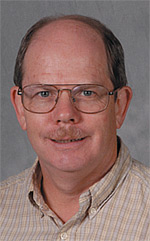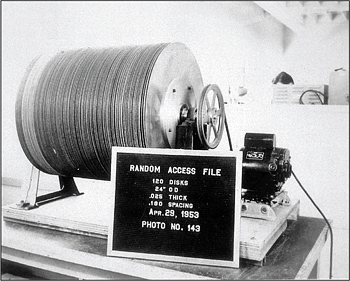Seeking Hard Disk Drive Latency

The year 1956 marked the beginning of an era that would dynamically and dramatically alter the landscape of technology forever. It was in San Jose, Calif., where the first hard disk drive (HDD), called the IBM 350, was invented by a group of by IBM scientists under the direction of Reynold Johnson. The 350 HDD would accompany the IBM 305 RAMAC (Random Access Method of Accounting and Control) computer and had a total capacity of five million 7-bit characters. A single head assembly with two heads accessed all 50 24-inch diameter platters, and the average access time was just under one second.
THE PRICE ON PERFORMANCE
Early HDDs had an areal density of only 2,000 bits per square inch and produced a data throughput of only 8.8 kbps. The pre-dawn era of massive HDD devices employed a spindle speed of less than 1,000 RPM, yielding a latency of 30 ms.
Disk drive improvements often appear more as statistics; the most prominent clearly noticed by the consistent growth in storage capacity and the steady increases in rotational (spindle) speeds. History has shown that rapid price reductions are often realized within the first six to nine months after the introduction of the next leap in capacity. Today, terabyte capacities are common. The first 1 TB drive being introduced at CES only two years ago went for nearly $1,000. Now the price for an external USB/Firewire 400 drive is now well below the $200 mark.
While capacity and reduced costs are both important factors for the storage industry, the rotational speed of the spindle (i.e., platter assembly) is another important performance specification that influences the specific applications for some drives versus others. Spindle speed statistics seem only to take modest jumps and are far less dramatic than the increasing number of gigabytes of storage.
Spindle speed is a measure of how fast the HDD platters spin during normal operation. The spindle speed affects, on average, how fast data can be recovered from the hard drive when requested by a controller. Spindle speeds directly determine rotational latency, a metric that surrounds the average seek time and in turn impacts read and write times, as well as accessibility. Seek time is the time required for the head to move from a worst case position to the requested track (or cylinder) where data to be retrieved is located. Once the head moves to the proper track, it must then wait for the platter to rotate until the data is positioned below the head. The sum of these times becomes the "seek time."
SPINDLE SPEED
From the 1960s forward, spindle speeds crept upwards until by the 1980s spindles for most HDDs were all powered by a DC motor and spun at a constant speed of 3600 RPM or less. By the 1990s the manufacturers began to realize the improvement benefits of faster spindle speeds and the RPMs began to rise from 3,600 RPM to 4,500 RPM. Eventually the high-end IDE/ATA drives and low-end SCSI drives reached 7,200 RPMs.
Latency is directly proportional to the rotational speed of the spindle and can easily be found when it is not stated in a specifications table. The value for latency can be calculated as: 30,000 divided by the spindle speed, expressed in milliseconds. Ironically, the incremental de-creases are not nearly as impressive as the increased numerical figures associated with the rotational speeds of the spindle. For example, the step from 5,400 to 7,200 RPM drives only shaves 1.4 ms off the average latency. The jump to 10,000 RPM drives only reduced the latency by another 1.16 ms.
THE LATENCY FACTOR

Early laboratory assembly of a disk drive that would become part of the RAMAC computing platform. Seek time and latency are most relevant to certain types of data accesses. For media-centric operations, latency becomes a true performance factor for such operations as nonlinear editing. When HDD operations require multiple frequent reads from random sectors on the disk, the seek time and latency become performance-limiting factors. For video servers, clip players or digital cinema servers that read large contiguous blocks of data, latency is a relatively minor factor because the speed impact only occurs while waiting to read the first sector of a file—after which the heads don't reposition much except at the end of a track. For nonlinear editing there are other factors, such as disk fragmentation, that further impact latency and seek times to a different degree.
Manufacturer cut sheets express rotational latency in terms of an average time. For newer 15,000 RPM SCSI drives, this average is about 2.0 ms. Accompanying that spec are the seek times which should be shown from two perspectives. First is the read/write time for a single track seek. Functionally, once the track is found and the actuator is positioned, a single seek time becomes the time it takes for the head to identify and settle on the precise spot where the data will be read from or written to. The second spec is the average seek time (which will be stated separately for both a read and a write), followed next by a maximum or worst case average seek time which is at least two times the average seek time for a read.
Typical specifications for a 300 GB SCSI drive with a rotational speed of 15,000 RPM will have a rotational latency average of 2.0 ms. The seek time for a single track read/write operation is 0.45 ms, with an average seek of 3.5 to 40 ms. The maximum seek time is 7.9 ms.
WEIGHING THE SPECS
Another benchmark test for drives is based upon tabulating the average number of input/output requests per second. A request will consist of both actuator (the arm that the head is attached to) and rotational positioning, followed by a block read or write. The block size is 8k for a workstation or database instance, and anywhere from 0.5k to 64k for a file server pattern. As a benchmark comparison between drive RPMs and the number of I/O requests per second—the 15,000 RPM drive benchmarks at 140 I/Os per second compared with 84 I/Os for 7500 RPM drives and 105 for 10,000 RPM drives. Summarily, a 15,000 RPM drive delivers a 33 percent increase in I/Os per second over 10,000 RPM drives which equates to a 28 percent improvement in "time-to-data" performance.
For professional broadcast server applications, these specs are carefully analyzed during the product design, development and HDD qualification period. This is why video server manufacturers prefer to provide the storage systems that are married to their specific software and hardware controller, I/O, and media managers. However, if you're adding drives or arrays to server platforms that are used for NLE, transcode engines, or graphics workstations—understanding these specifications and knowing where or how to employ the growing variety of eSATA, SAS, iSCSI and Fibre Channel drive arrays in your system is valuable indeed.
Karl Paulsen is chief technology officer for AZCAR Technologies, a provider of digital media solutions and systems integration for the moving media industry. Karl is a SMPTE Fellow and an SBE Life Certified Professional Broadcast Engineer. Contact him atkarl.paulsen@azcar.com.
Get the TV Tech Newsletter
The professional video industry's #1 source for news, trends and product and tech information. Sign up below.

Karl Paulsen recently retired as a CTO and has regularly contributed to TV Tech on topics related to media, networking, workflow, cloud and systemization for the media and entertainment industry. He is a SMPTE Fellow with more than 50 years of engineering and managerial experience in commercial TV and radio broadcasting. For over 25 years he has written on featured topics in TV Tech magazine—penning the magazine’s “Storage and Media Technologies” and “Cloudspotter’s Journal” columns.
